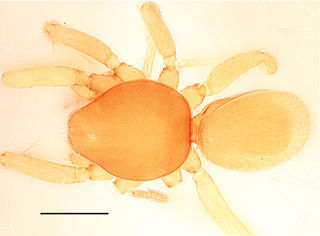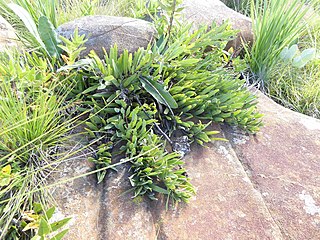Related Research Articles

Quercus wislizeni, known by the common name interior live oak, is an evergreen oak, highly variable and often shrubby, found in many areas of California in the United States continuing south into northern Baja California in Mexico. It generally occurs in foothills, being most abundant in the lower elevations of the Sierra Nevada, but also widespread in the Pacific Coast Ranges ─ where since 1980 it has been known as a separate species Quercus parvula ─ and the San Gabriel Mountains. It was named for its collector, Friedrich Adolph Wislizenus (1810–1889).

The common dwarf mongoose is a mongoose species native to Angola, northern Namibia, KwaZulu-Natal in South Africa, Zambia and East Africa. It is part of the genus Helogale and as such related to Helogale hirtula.

Urodidae or "false burnet moths" is a family of moths in the lepidopteran order. It is the type genus in the superfamily, Urodoidea, with three genera, one of which, Wockia, occurs in Europe.

The little yellow bat is a species of vesper bat found only in Mexico.

Eleocharis parvula is a species of spikesedge known by the common names dwarf spikerush, small spikerush and hairgrass in aquaria. It is a plant of brackish and saltwater habitat, such as marshes and mudflats. It is a perennial herb growing tufts of spongy, compressible stems not more than 10 centimeters tall. The plant grows from a tuber which is J-shaped or horseshoe-shaped, a characteristic that helps in the identification of the species. The inflorescence is an oval-shaped spikelet just 2 or 3 millimeters long, made up of several tiny flowers.

Quercus parvula, the Santa Cruz Island oak, is an evergreen red oak found on north-facing Santa Cruz Island slopes and in the California Coast Ranges from Santa Barbara County north to Mendocino County. It was taxonomically combined with Quercus wislizeni until resurrected as a separate species by Kevin Nixon in 1980. The type locality of Q. parvula var. shrevei is Palo Colorado Canyon in Monterey County.

Grevillea parvula , commonly known as Genoa grevillea, is a species of the plant genus Grevillea. It is native to the states of Victoria and New South Wales in Australia.
Holothuria parvula, the golden sea cucumber, is a species of echinoderm in the class Holothuroidea. It was first described by Emil Selenka in 1867 and has since been placed in the subgenus Platyperona, making its full scientific name Holothuria (Platyperona) parvula. It is found in shallow areas of the Caribbean Sea and Gulf of Mexico and is unusual among sea cucumbers in that it can reproduce by breaking in half.

Scutellaria parvula, commonly known as the small skullcap, is a member of the mint family. It is native to eastern and central North America, being most common in the central states and become rare in the east. It is found in areas that provide ample sunlight, such as prairies, glades, and savannas, often in calcareous soil. Flowering time is from late spring to early summer.

Pterolophia is a genus of longhorn beetles of the subfamily Lamiinae, containing the following species:

Bannana is a genus of goblin spiders native to Xishuangbanna prefecture, Yunnan Province, China, where it lives in the leaf-litter of tropical rainforest. There are two known species: Bannana crassispina and B. parvula, both described in 2015. Individuals are pale yellow and unpatterned, and range from around 1.0 to 1.8 mm in body length, with females being slightly larger than males. The eyes are reduced or entirely absent. Known only from a nature reserve in Xishuangbanna, Bannana belongs to a group of Asian goblin spiders known as the "Dysderoides complex", that ranges from China to Pakistan and south to Indonesia.

Pachycondyla parvula is an extinct species of ant in the formicid subfamily Ponerinae described by from a fossil found in Europe. P. parvula is one of six Lutetian Pachycondyla species.
Nepenthes parvula is a tropical pitcher plant native to the Cape York Peninsula of Queensland, Australia.

Pterolophia melanura is a species of beetle in the family Cerambycidae. It was described by Francis Polkinghorne Pascoe in 1857. It has a wide distribution in Asia.
Pterolophia instabilis is a species of beetle in the family Cerambycidae. It was described by Per Olof Christopher Aurivillius in 1922. It is known from Seychelles.
Pterolophia guineensis is a species of beetle in the family Cerambycidae. It was described by James Thomson in 1864, originally under the genus Alyattes.

Zaitzevia thermae, also called the warm springs zaitzevian riffle beetle, is a flightless, wingless small beetle found in aquatic habitats in Montana.
Rhogeessa velilla, also called the Ecuadorian little yellow bat, is a species of vesper bat in the genus Rhogeessa. It is found in Northwestern Peru and parts of Ecuador. The species was previously included in R. io, but is now recognized as a separate species. Very little is known about this species, though it is generally considered to be insectivorous.

Protea parvula, also known as the dainty sugarbush, or kleinsuikerbos in Afrikaans, is a small flowering shrub belonging to the genus Protea.
References
- ↑ BioLib.cz - Pterolophia parvula. Retrieved on 8 September 2014.